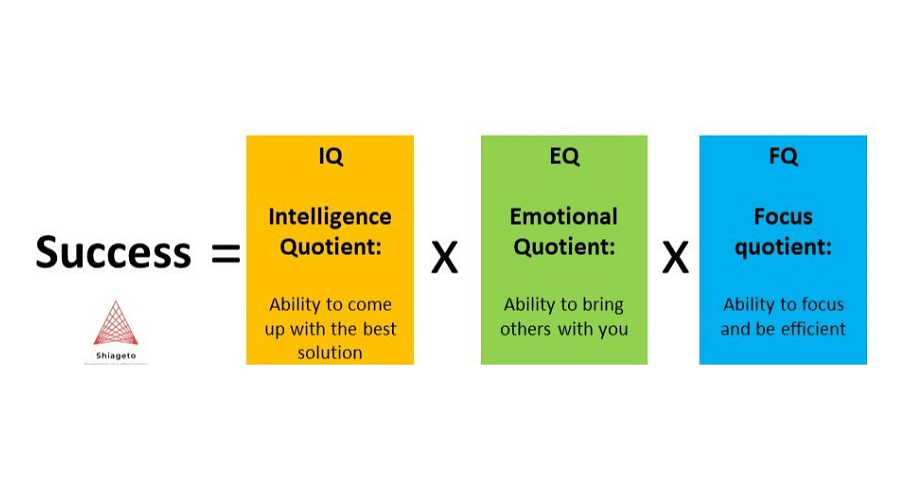
As this entrepreneur experienced, sending voice notes on LinkedIn can make cold leads warm
By Jim James, Founder EASTWEST PR and Host of The UnNoticed Entrepreneur.
Faris Aranki is an effectiveness facilitator and coach. He’s had a long and illustrious career, and in the new episode of The UnNoticed Entrepreneur, he talked about how he’s using some tools that he learned to build engagement and how voice notes, notably on LinkedIn, can get an 80% conversation rate on cold leads.
Image from LinkedIn
Shiageto Consulting’s Three Pillars
Faris runs a business called Shiageto Consulting. Shiageto is the Japanese word for a sharpening stone, and his business is named as such because they sharpen other businesses — just like anybody would when they got a dull knife.
They do that through three pillars: IQ, or intelligence quotient, refers to someone’s ability to come up with ideas; EQ, or emotional quotient, is someone’s ability to take others on their journey with them; and FQ, or focus quotient, which is about how focused is an individual in delivering their ideas.
When an entrepreneur puts all these three together, they will achieve success. They will unlock their strategy and be effective.
Image from LinkedIn
Faris built his business three and a half years ago, just before COVID-19. He had to experience the pains of COVID-19 just six months after they were born. But his backstory is that he was a Strategy Consultant for some blue-chip strategy firms. He worked in the energy industry — on the strategy team of a large energy company. A long time ago, he started as a school teacher. And he’s been using many techniques he developed over those years from all these arenas.
The Essence of Being Focused
When Faris goes into companies, he realises they’re not focused enough at the corporate and individual levels. Too many companies say that they’ve got a hundred strategic projects. But in reality, a person wouldn’t have a hundred things important in their life at the same time.
Though these companies know that, they’re unwilling to let go of things. However, doing ten things really well is far better than a hundred diluted.
Doing many things entails business owners asking their staff to make daily choices and micro decisions. But if an entrepreneur can give their staff that clarity and focus, they can make the company and their staff better, more productive, and more effective.
This is the essence of FQ. And it also applies to other people. For example, someone may have to write a report, but then they’d be distracted by their phone. Because of that, they won’t be giving their task the 100% focus that it demands.
Though people don’t realise it, lots of things in life rub them off their focus from emails (e.g., they’re hungry, they feel cold, they’ve just had an argument with a loved one). The more they can close those off, the more they can be focused and deliver quality work on what they should be working on.
Applying the Success Formula to Himself
When Faris started his company, it was going well. It all fell off a cliff because of COVID — they had no work. He was back to square one.
During that time, he realised that everyone was at home; the volume of communication and information there was all being magnified. Everyone was doing webinars and emails. Everybody was trying to reach out.
He took a step back, and this was where the IQ part came out. He asked himself: I need to connect with my customers or potential customers. How can I cut through the noise?
He generated all his ideas, including those he’d tried before and those he hadn’t tried. He weighed the pros and cons. The FQ came in when he realised he should just pick one that would be really effective.
He knew he shouldn’t try and do a little bit of everything, like doing a bit of cold calls and a bit of webinars. He must pick one thing. The thing that has worked for him was voice notes, which have proven successful.
However, doing that might not be for everyone. As a piece of advice, Faris always says that if someone doesn’t get energy from it, they mustn’t do it. If they love to go and shake hands at a conference, they must make that their FQ. If they love webinars, they must make that their FQ.
When it comes to using EQ, he thought of how he can do a voice note that is full of EQ, engaging, drawing the other person in, and standing out as something memorable. It’s what he perfected, and it’s what has been driving the core of his business.
Image from Freepik
On LinkedIn, one can only use voice notes on the mobile application. And often, it’s the reason a lot of people are completely unaware of the fact that they can make a voice note on the platform.
Before doing it on LinkedIn, he was doing it on Facebook. When his friends’ birthdays would pop up, they would get a personalised voice note from him. At one point, he thought of trying it on LinkedIn. He doesn’t need new connections because he has enough connections. All he needed to do was find a reason to send them a very warm voice note.
LinkedIn is full of reasons to contact people. It could be their birthday, or maybe they’ve just changed a job, written a report, or posted something about what’s happening in their life.
During his first cup of coffee, Faris picks 25 to 30 people from whatever stimuli he gets on LinkedIn. He sends them a voice note that’s no more than 30 seconds. He can fire those off over the course of drinking his coffee (It took him about two years to perfect a great voice note). Lo and behold, about 80% of them reply, which is more than good enough for his business.
The Anatomy of an Effective Voice Note
Earlier in Faris’ career, somebody told him that the best next customer he’ll ever have is the one he already has. This simply means that entrepreneurs shouldn’t go chasing somebody they need.
When it comes to voice notes, the note shouldn’t be too long.
People’s attention spans are a thing. But there’s also a curiosity factor. Today, voice notes on LinkedIn are still in a stage where many people have never seen them yet. So when one pops up, it can be quite intimidating. Hence, it shouldn’t be a minute or two-minute-long. Otherwise, the other person won’t be investing time in that. Less than 30 seconds is key.
Moreover, the tone has to be warm and cordial. The note will have nothing to do with selling. It’s not an “I have this fantastic product, and I really wanted to reach out” statement. It’s more like, “Hey, Jim. I just saw your post on LinkedIn. It made me think of you and the time that we shared. It would be great to catch up for a coffee sometime. What do you think?”
It’s important to leave an action and a hook at the end.
Doing this takes only 20 seconds. It will be amazing if it’s delivered genuinely in the right tone — not like how someone is reading off a script. Essentially, anyone who sends a voice note must get the other person to remember them and the experience they shared and prompt them to agree to the call-to-action at the end of the note.
Image from Freepik
Managing Voice Notes and Leads
Once the recipients reply to voice notes, it can, to some degree, create a potential of overwhelm at the sender’s end. And this is where the FQ comes back into play.
Voice notes require project management and customer relations management skills because senders need to carry on those conversations.
In Faris’ case, he immediately tries and schedules something. He learned long ago that people's attention is usually seven to ten days. And so he gets something done within the next seven to ten days, even if it’s just a quick catch-up. Usually, he directs it to a virtual coffee because it saves him a lot of hassle logistically.
When someone replies, “Let me get back to you,” he puts it on his calendar immediately. A week after he receives that reply, a certain colour code will also pop up in his Outlook Calendar, reminding him to follow up with that person. After another seven to ten days, there will be a second reminder to close off the conversation if it didn’t have a positive outcome or if it doesn’t look like they’re going to arrange something. And that will be a different colour as well.
The recipient of the initial voice note will also get reminders. If Faris doesn’t get anything back, he will send a formal close-off reminder along the lines of, “Oh, Jim, you know, clearly, we weren’t able to work this out. Maybe it’s further down the line. But as far as I’m concerned, I will take this off my to-do list because I’m a busy guy.” About 50% of the time, people who receive that quickly come back and say they were just occupied.
This is Faris’ system. He doesn’t overcomplicate it, and he’s just using Outlook. But there’s a process to it. He’s giving prods and he’s providing people with the signposting they need.
Beyond Sending Voice Notes
Faris backs up his voice notes because, for him, senders are more than just their voice notes. He uses voice notes as his main engine, and he blogs once a week. He also appears on podcasts and does speaker events.
He’s creating an ecosystem around him and his company to draw people in. He plays on that EQ component, allowing people to feel they are part of the journey. They’re invested; they’re interested.
The blogs and events he does are full of sharing personal things and building trust. Recently, he was on holiday, and he blogged about it. That blog about his holiday had more views than articles about strategy and the like. And during calls, people have also been asking him about his holiday.
Building trust and a relationship is a supporting aspect that really complements voice notes and fits in nicely.
Image from Pexels
Faris does his blogs on Medium and links them on his LinkedIn, so they stay as a compiled body of work. Because if he does them on LinkedIn, they can get lost in the feed. In the past year, his feed has been picked up by a couple of other websites and newsletters and has gotten showcased.
He firmly believes that if someone keeps building, good things will happen. Faris’ number of views went from 20 people for each blog two years ago to 200 to 250 people now.
Faris often tells people that it’s not just about doing one activity. It’s about a combination of things. So they must not lose faith because if they’re doing good things — if they’re feeding the beast — the beast will feed them eventually.
There are a couple of blogging websites out there, and Medium and Substack are the two most prolific. They allow people to build a profile and attach all their blogs so they’re in one place and readers can just come. Whereas on LinkedIn, people have to scroll through other posts.
Platforms like Medium are purely about blogs. Another great thing is that it’s where magazines and newsletters go to find feeds. And, crucially, if a blogger reaches a certain number, they start to get paid. For instance, an individual will need 100 followers to start to get revenue.
Medium has a free and paid-for level. If someone reaches the hundred figure, they will get a share of the subscriptions, depending on how many people read their blogs. If someone is a really good writer, it’s a good additional revenue stream.
Using EQ to Approach Potential Customers
Faris believes people could use more EQs in their lives. If an entrepreneur is approaching leads, they must approach a conversation as though they are there to listen — not to speak.
Too often, salespeople do 80% of the talking when it should be the other way around. They should ask more questions, listen more, and mirror the other person’s language and how they’re speaking.
If the other end is a detailed person, they must go into detail. If they’re a big-picture person, they must stay at the big picture. It’s really about reading the room and making their style flexible. Faris calls this the “platinum rule.”
As children, people were taught the golden rule — that they must treat others how they want to be treated. In the platinum rule, if someone wants a high EQ, they must treat others how they want to be treated.
Salespeople and entrepreneurs can either ask potential customers or pay attention and adapt. This will help them become far more effective.
Image from Pexels
An Anecdote of How Faris Landed a Client
Faris is the kind of person who loves receiving cold calls. He replies to everyone and sees it as a chance to meet someone new and practise.
Once, he was sitting at his desk when his phone rang. It was a Recruitment Consultant trying to sell him his business, which is in recruitment consulting. That person spoke for 10 minutes and didn’t literally give him time to breathe.
At the end of the conversation, when Faris kept saying no, the caller asked what Faris does. To this, Faris responded that the consultant should have researched that beforehand.
Then, Faris demonstrated to the consultant what he does: He took the person through how he lacked emotional intelligence during those 10 minutes. He didn’t pause long enough. He didn’t ask Faris a question. He didn’t use the same language that Faris used. When Faris showed confusion, he didn’t summarise or use an anecdote to help him.
The other person found what Faris did amazing and asked if it was something he could teach. When Faris said yes, the consultant requested him to teach him and his team how to be better salespeople.
Off the back of a cold call, he ended up with a day’s work for a consulting firm. Until now, they’re still his clients. He goes there once a year to train their new recruits.
This doesn’t only apply to sales calls. It could be someone’s loved one — their daughter, son, husband, or wife — whom they could listen to a bit more and show a bit more EQ.
Creating New Things vs Creatively Promoting One Thing
The number one thing Faris would advise anyone is to keep the faith. And similar to the abovementioned advice about how one’s best next customer is the one they already have, they must use the artefacts they already have to promote their business.
They don’t need to go out creating new things. Rather, they must start with what has already worked. It could be a great piece of work they’ve done somewhere. For instance, can they think smartly? How can they use that more? Can they get a client to write a testimonial about it? Can they splice it up, anonymise it, and put it out into the market? Can they get somebody else to write an article about it? Can they go on a podcast and promote it?
An entrepreneur only needs one really good piece of work or project. And if they are creative enough, they can think of 10 ways to use it.
Too many people rush off to just build something else, thinking that they’ll be successful. The truth is that they’ve already got the keys around them; they simply need to unlock the doors.
To find out more about Faris, visit his LinkedIn page. To learn more about his company, visit www.shiageto.com.
The UnNoticed Entrepreneur podcast is sponsored by Prowly, the all-in-one software for leveraging PR activities. Boost the media relations game for your business - get more coverage while saving time and money on everyday tasks.
This article is based on a transcript from my podcast The UnNoticed Entrepreneur, you can listen here.
Cover image by ijeab on Freepik







